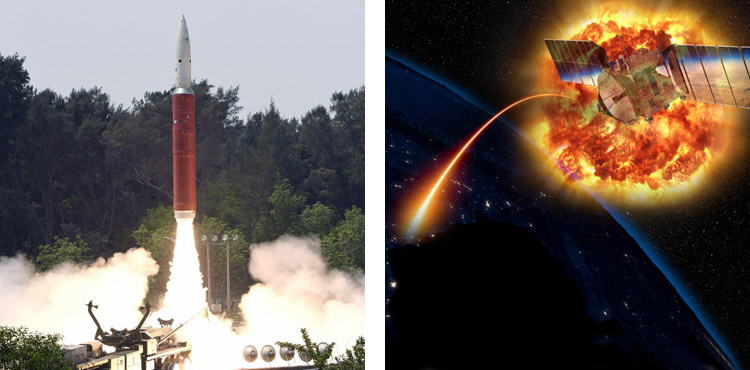INDIAN ARMED FORCES CHIEFS ON
OUR RELENTLESS AND FOCUSED PUBLISHING EFFORTS

SP Guide Publications puts forth a well compiled articulation of issues, pursuits and accomplishments of the Indian Army, over the years

I am confident that SP Guide Publications would continue to inform, inspire and influence.

My compliments to SP Guide Publications for informative and credible reportage on contemporary aerospace issues over the past six decades.
India setting up agency to develop weapons for space warfare
Space weapons to be made in close coordination with military

Close on the heels of a successfully testing an anti-satellite (A-SAT) weapon, India is setting up an agency to develop technology and weapons for space warfare.
The go-ahead for the setting of the Defence Space Research Organisation (DSRO) was given recently by the Cabinet Committee on Security (CCS) chaired by Prime Minister Narendra Modi, informed sources confirmed to SP's.
The DSRO will be an independent organisation which will report to the Defence Minister. It will support the tri-service Defence Space Agency (DSA), which will operationalise India's military capability directed at space and also "set up an eco-system to fight space wars". The DSA is being set up in Bengaluru, and Air Vice Marshal SP Dharkar has been named as its first head.
"The new agency for developing space weapons will be independent of the Defence Research and Development Organisation (DRDO), although it could draw most of its scientists from that organisation besides the Indian Space Research Organisation (ISRO)," sources explained.
The DSRO will be an independent organisation which will report to the Defence Minister. It will support the tri-service Defence Space Agency (DSA), which will operationalise India's military capability directed at space and also "set up an eco-system to fight space wars". The DSA is being set up in Bengaluru, and Air Vice Marshal SP Dharkar has been named as its first head.
India's March 27 A-SAT test was conducted by the DRDO in concert with ISRO. The DRDO fired its ballistic missile defence interceptor, the Prithvi Delivery Vehicle (PDV Mk-II) and destroyed a Microsat-R satellite launched by ISRO on January 24 in low-earth, sun-synchornous orbit at an altitude of 282 km. The A-SAT test was dubbed Mission Shakti. It was explained by India as a deterrence capability.
"An independent existence for the space weapons development agency reflects the importance given by the establishment to this subject," sources explained.
The DSRO will work closely with the military agency DSA both to develop and operationalise space weapons.
India is among only four countries have demonstrated space warfare capability.
India's March 27 A-SAT test was conducted by the DRDO in concert with ISRO. The DRDO fired its ballistic missile defence interceptor, the Prithvi Delivery Vehicle (PDV Mk-II) and destroyed a Microsat-R satellite launched by ISRO on January 24 in low-earth, sun-synchornous orbit at an altitude of 282 km. The A-SAT test was dubbed Mission Shakti. It was explained by India as a deterrence capability.
The US is leading the way, with its President Donald Trump recently disclosing the concept of a US Space Force.
Earlier this week, India disclosed its plan to set up a space station in 10 years. It is also close to the launch its Moon mission Chandrayaan, in which it intends landing a vehicle on the surface of the lunar satellite. A manned space mission, Gaganyaan, is slated for later.
India's space weapons programme will be closely linked to its overall capability as a space power.
While in principle, India is opposed to militarisation of space, it is developing a capability to deter adversaries from destroying its assets in space. The vulnerability stems from overwhelming dependence for communication and navigation on space-based assets.





